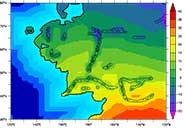EARTH SCIENCES
Lunt simulates the climate of Tolkien’s Middle Earth

Ever wondered what the weather and climate was like in Middle Earth, the land of hobbits, dwarves, elves and orcs, from J.R.R. Tolkien’s The Hobbit and The Lord of the Rings? Climate scientists from the University of Bristol, UK have used a climate model, similar to those used in the recent Intergovernmental Panel on Climate Change (IPCC) report, to simulate and investigate the climate of Middle Earth.
The results show that The Shire, where the hobbit Bilbo Baggins lived before he was whisked away on his unexpected adventure described in The Hobbit, had a climate very similar to that of Lincolnshire and Leicestershire in the UK. However, Mordor, the land of the evil Sauron, had a climate similar to that of Los Angeles and western Texas.
The results are presented in a paper, penned by the wizard Radagast the Brown (probably the first environmental scientist). Among other findings, he explains why the elves set sail from the Grey Havens (the prevailing winds were favourable for their journey to the West), and the existence of a dry climate east of the Misty Mountains (the mountains cast a rain-shadow over the region). Radagast also discusses the strengths and weaknesses of contemporary climate models, and shows how they can be used to understand and predict future climate.
Professor Richard Pancost, Director of the Cabot Institute at the University of Bristol said: “Because climate models are based on fundamental scientific processes, they are able not only to simulate the climate of the modern Earth, but can also be easily adapted to simulate any planet, real or imagined, so long as the underlying continental positions and heights, and ocean depths are known.”
Dr Dan Lunt added: “This work is a bit of fun, but it does have a serious side. A core part of our work here in Bristol involves using state-of-the-art climate models to simulate and understand the past climate of our Earth. By comparing our results to evidence of past climate change, for example from tree rings, ice cores, and ancient fossils of plants and animals, we can validate the climate models, and gain confidence in the accuracy of their predictions of future climate.”
The IPCC, including several scientists from the University of Bristol, have shown that climate models can successfully simulate climates from the freezing world of the last Ice Age, to the intense warmth of the ‘Eocene greenhouse’, 50 million years ago. These same models are then used to simulate the future climate of our planet.
Paper
‘The Climate of Middle Earth’ (PDF, 5.17MB) by Radagast the Brown, describes the results in full, and translations are available for elves (PDF, 5.54MB) and dwarves (PDF, 5.52MB).
The model simulations were carried out on the supercomputers of the Advanced Centre for Research Computing at the University of Bristol. They were not funded in any way, and were set up in the author’s spare time.


 How to resolve AdBlock issue?
How to resolve AdBlock issue?